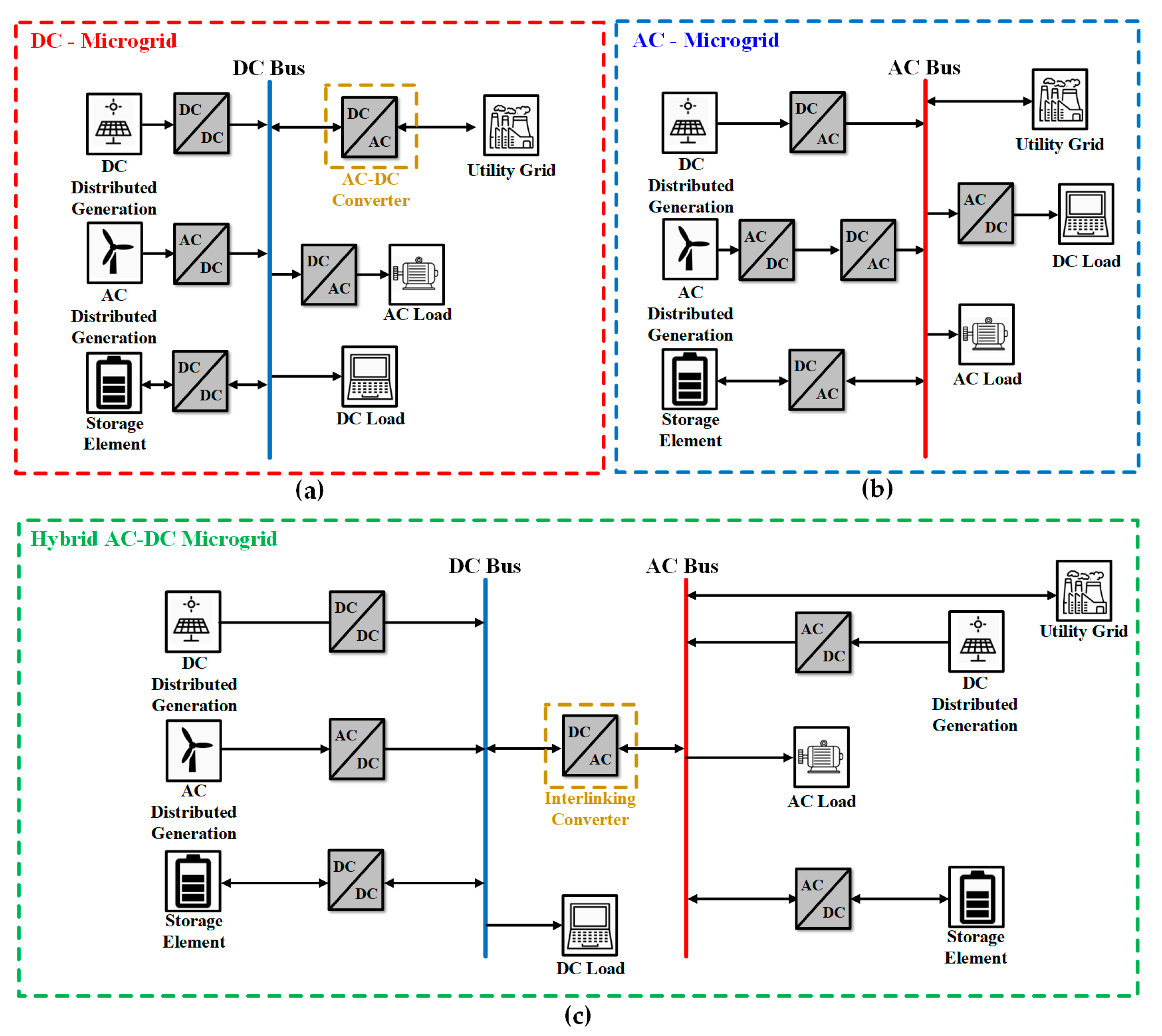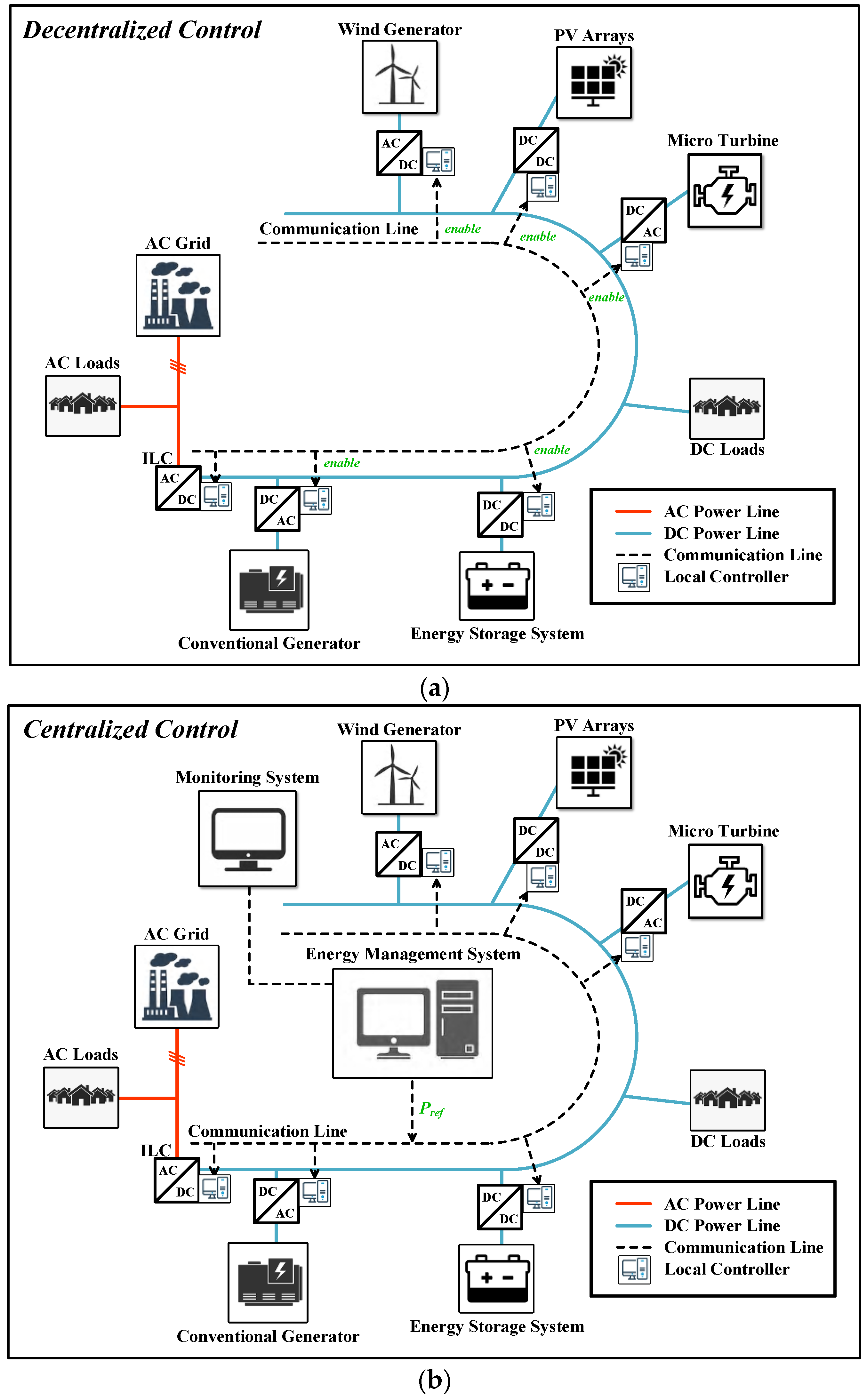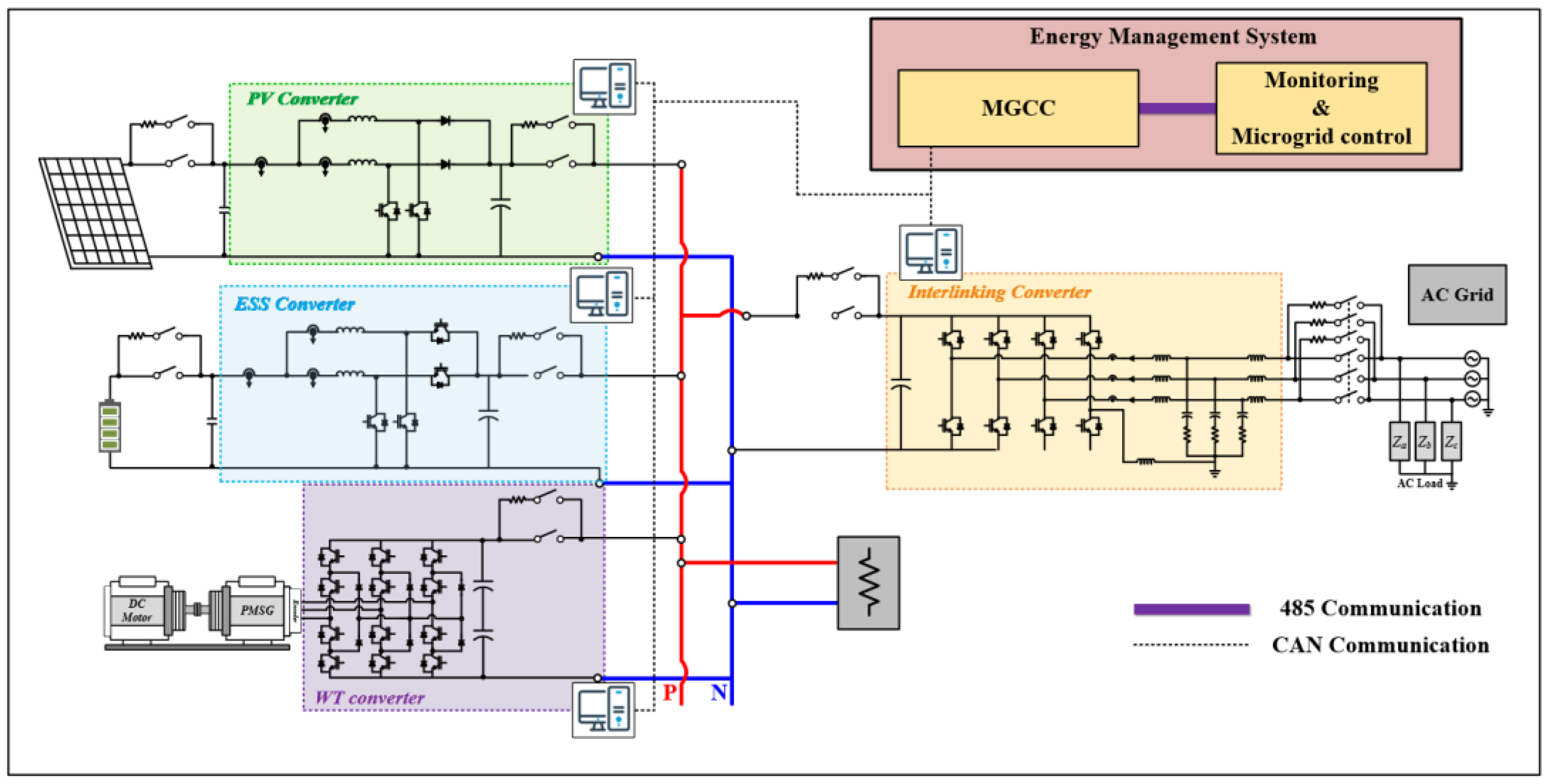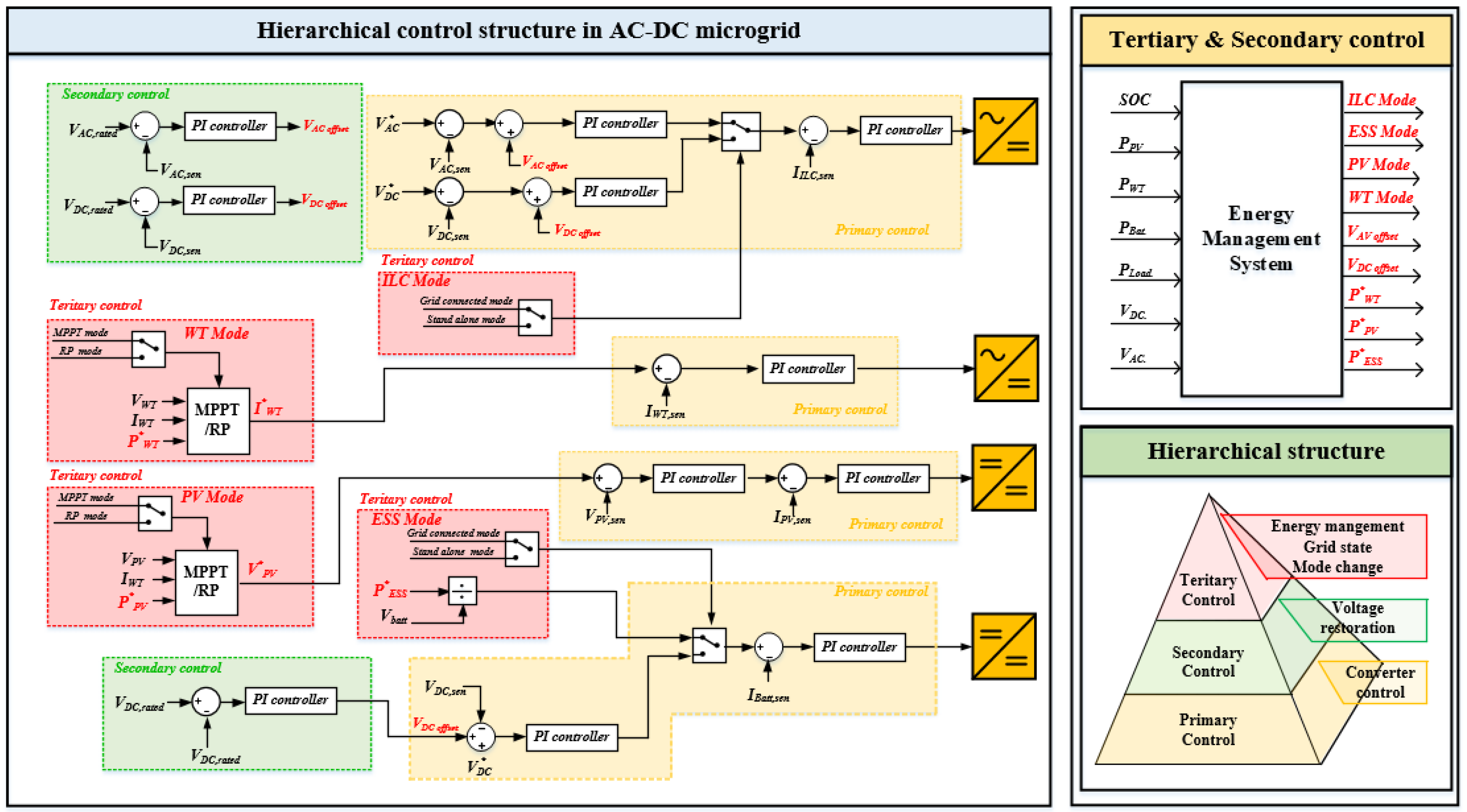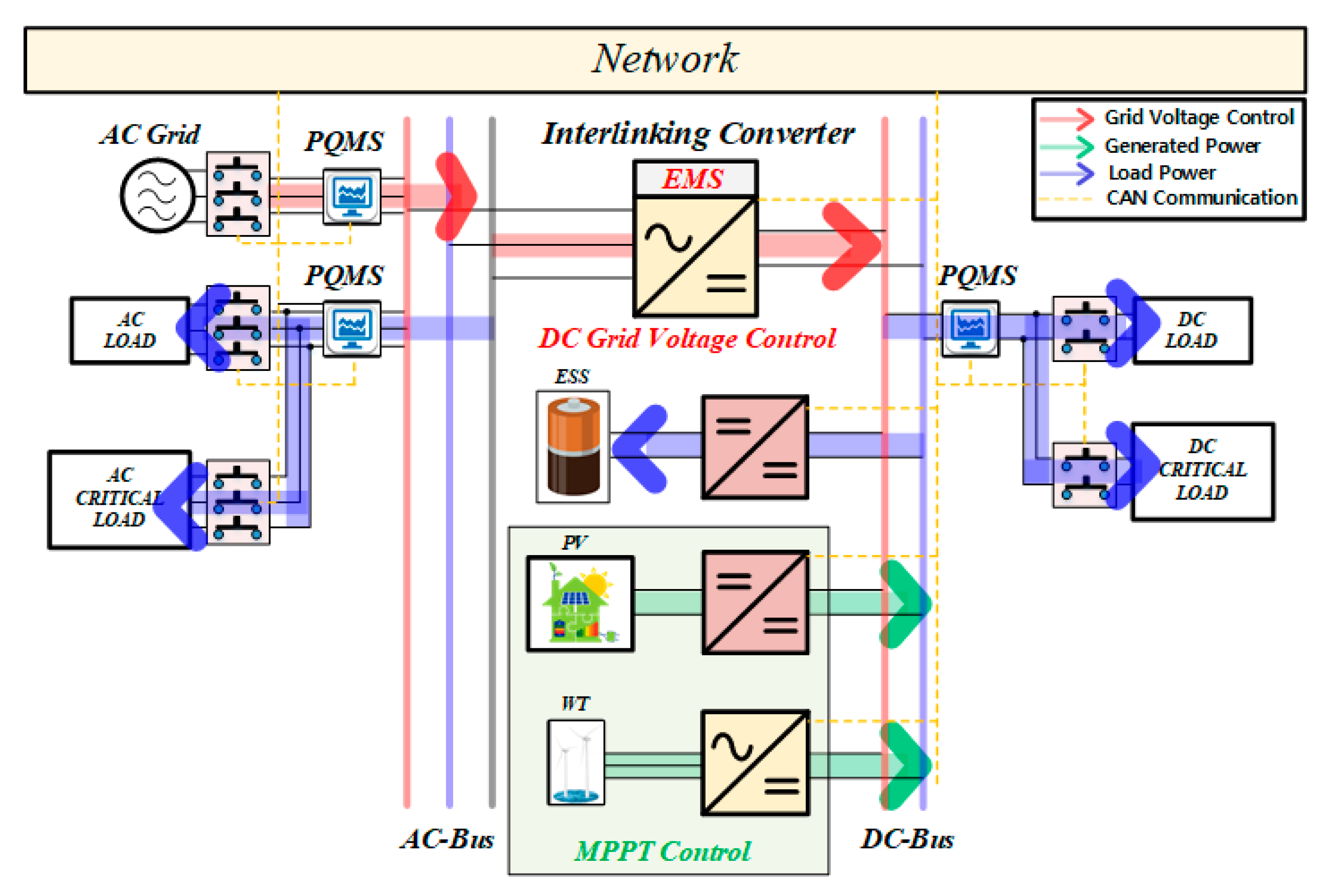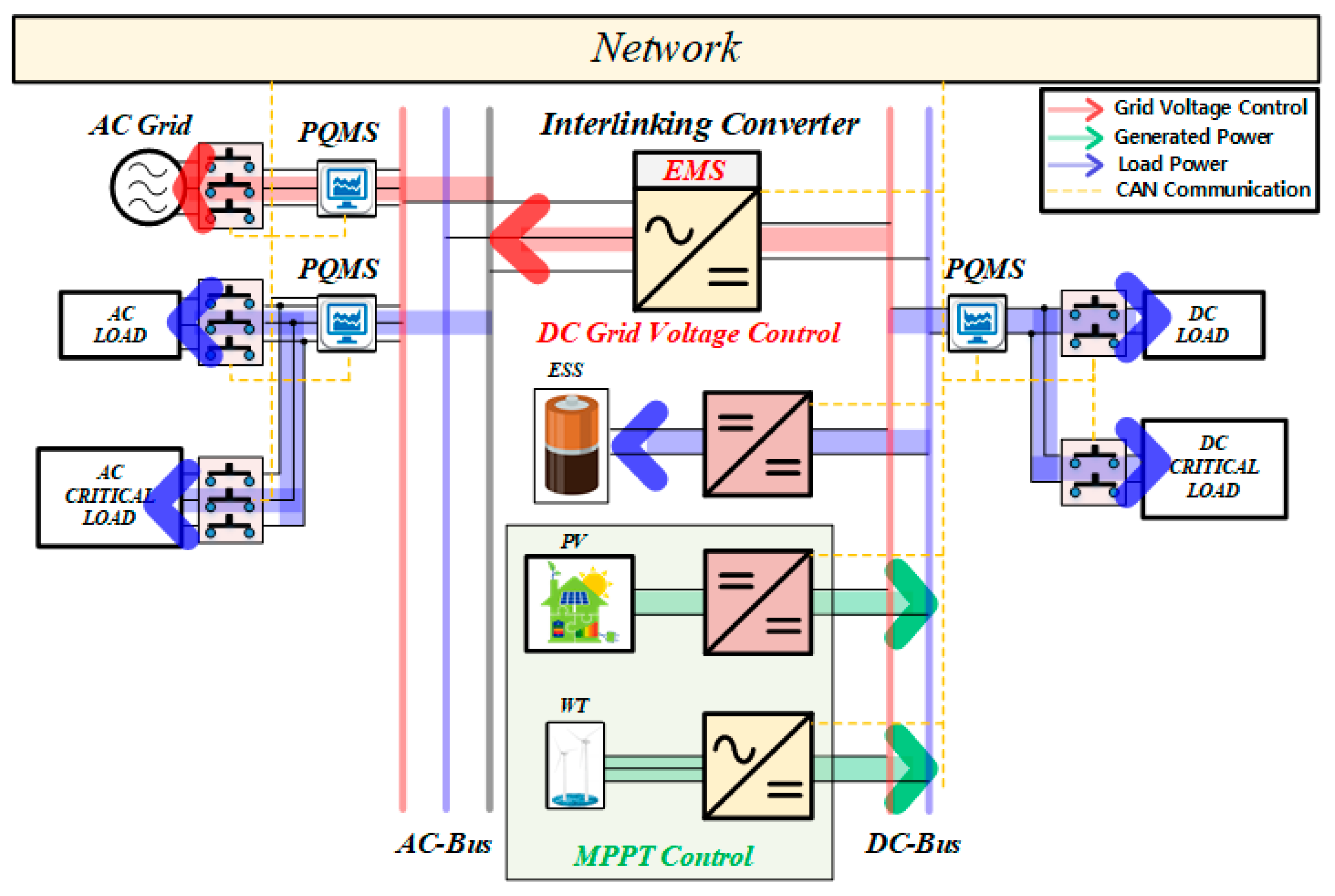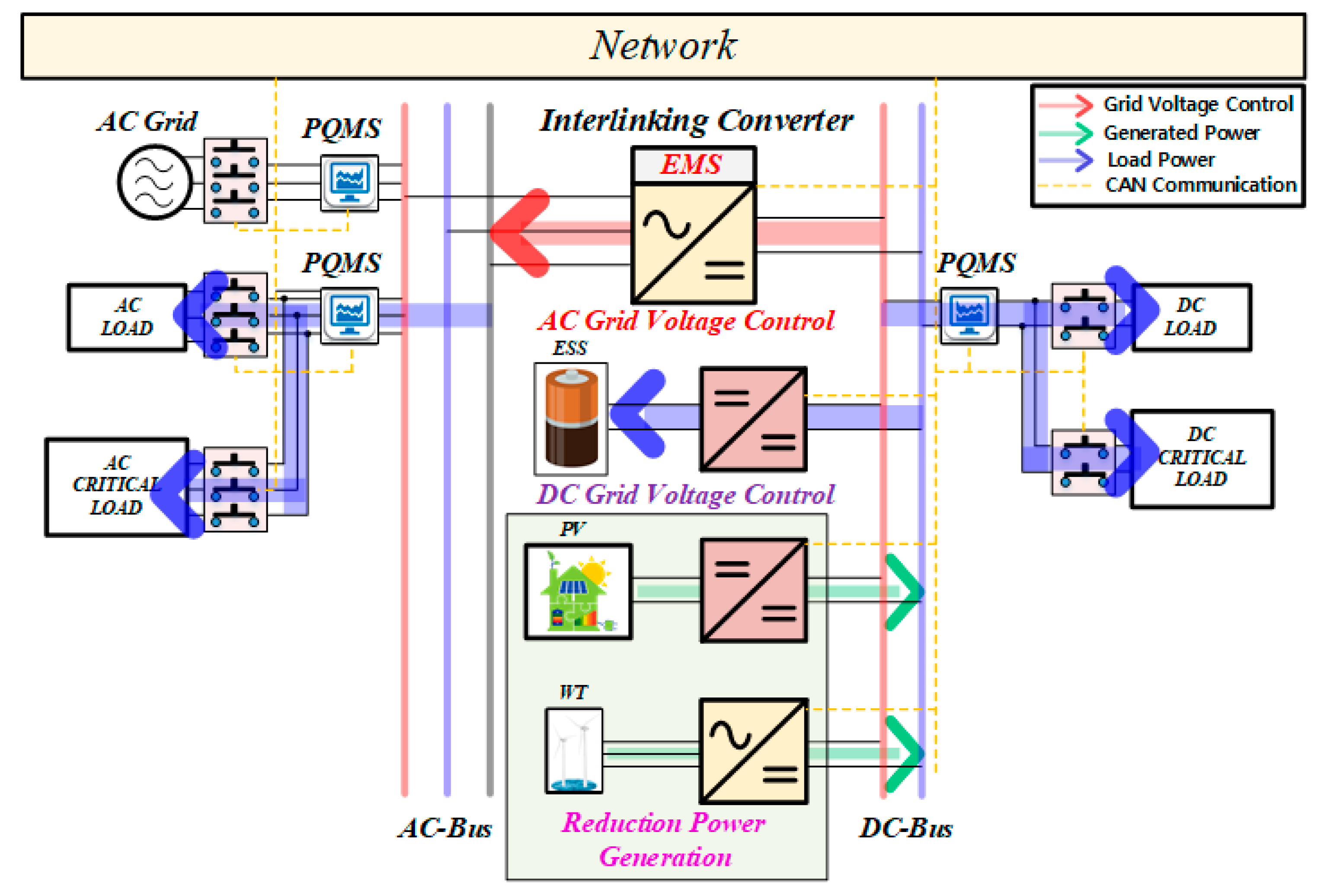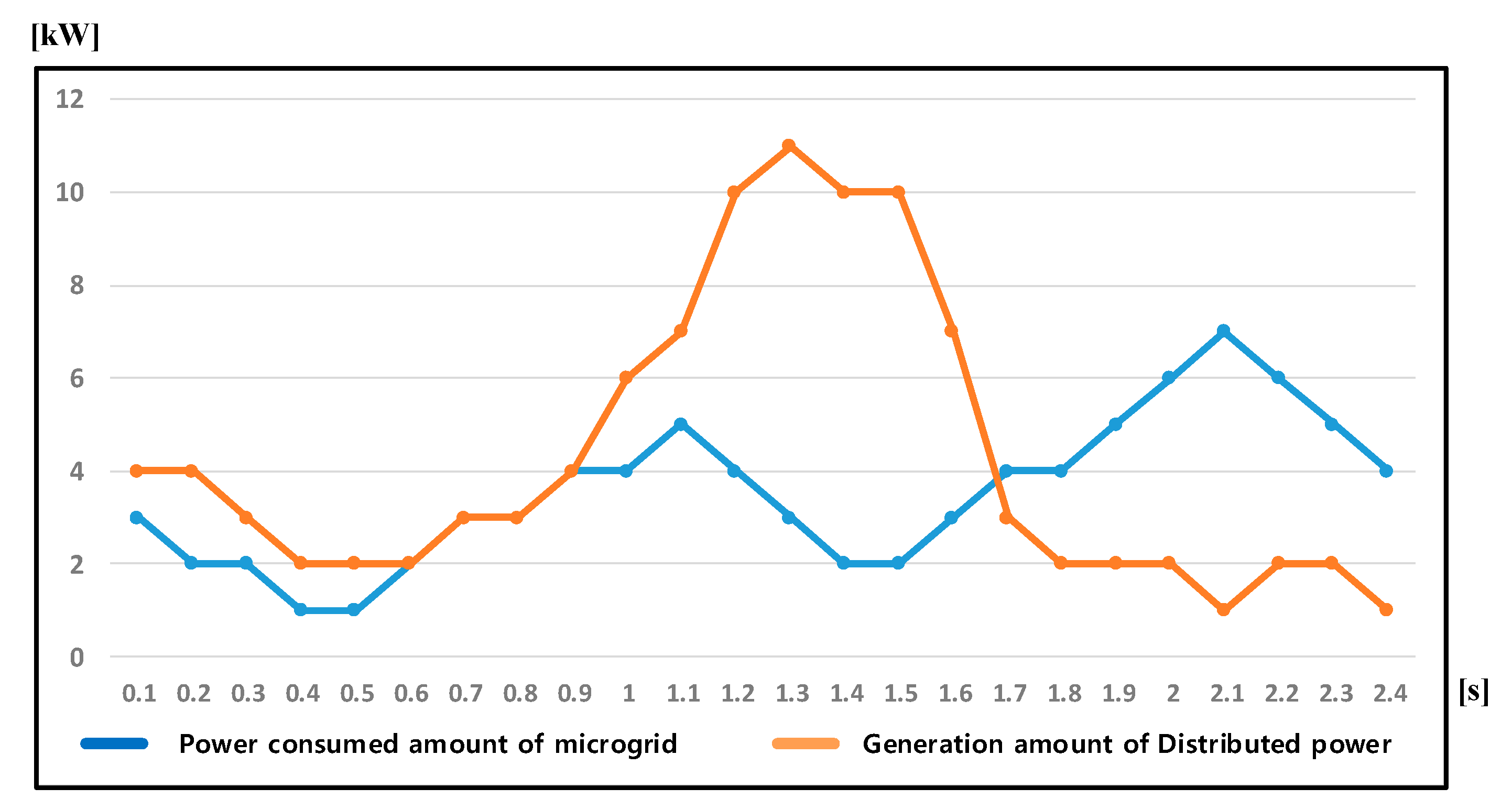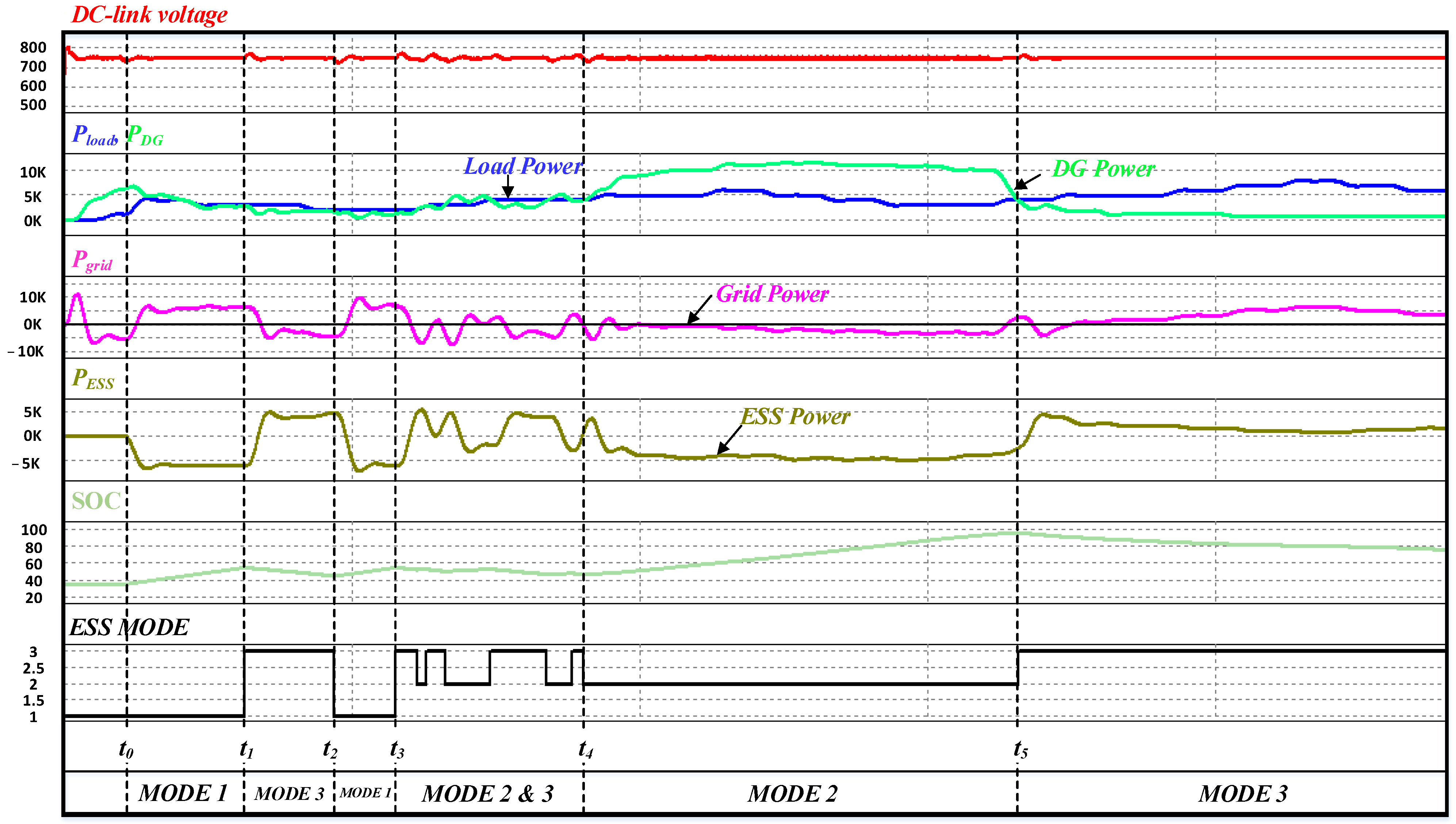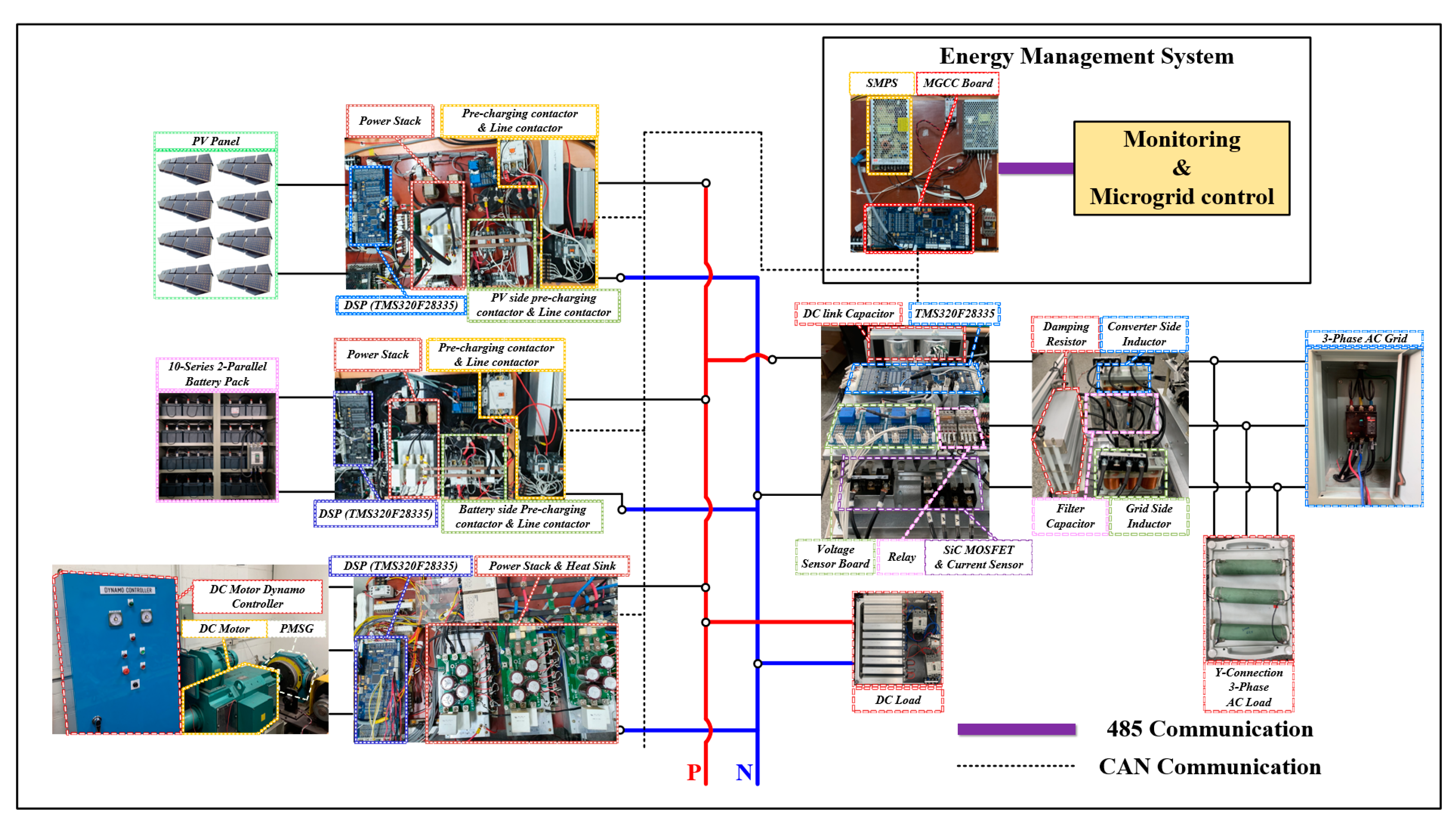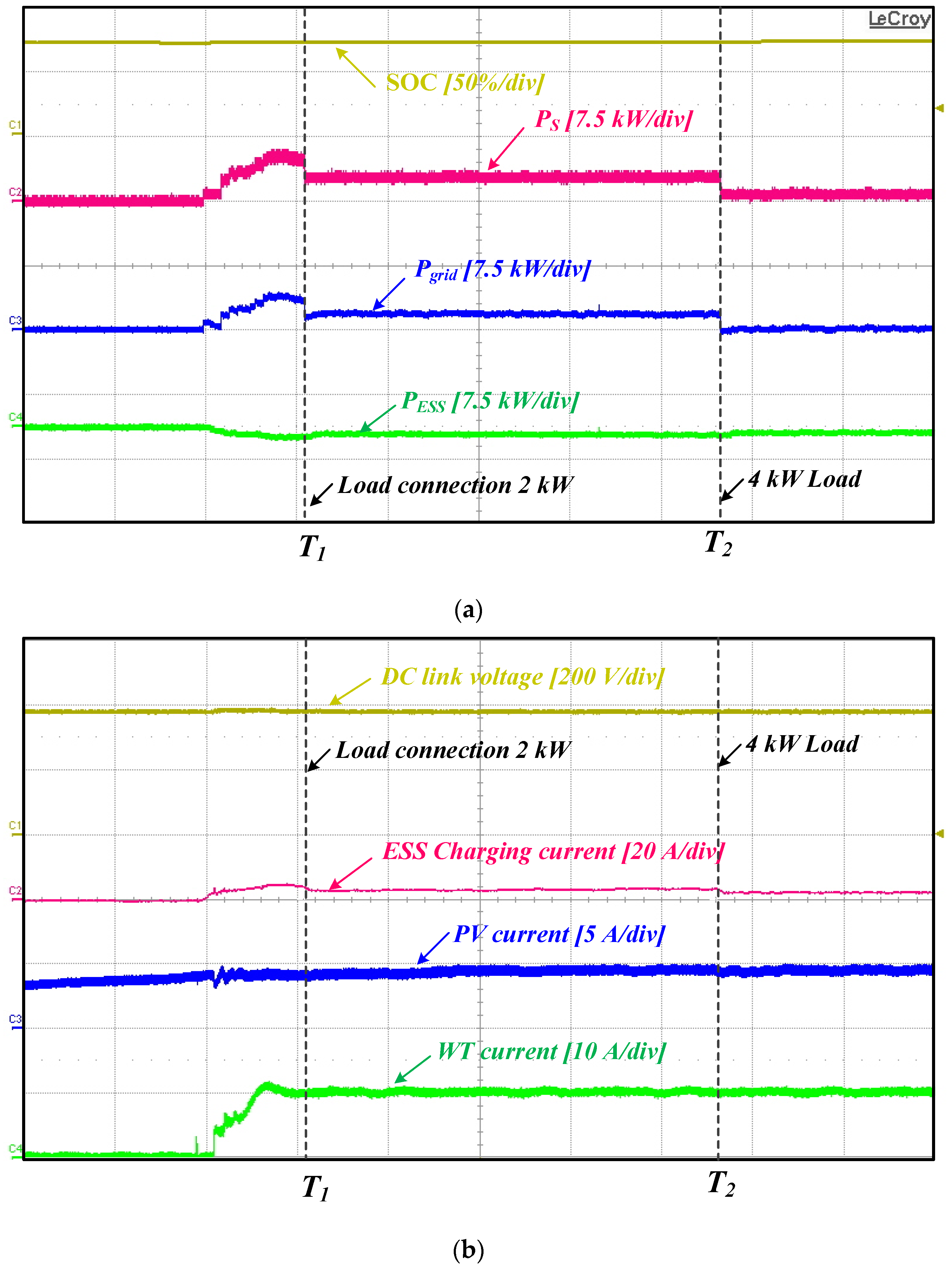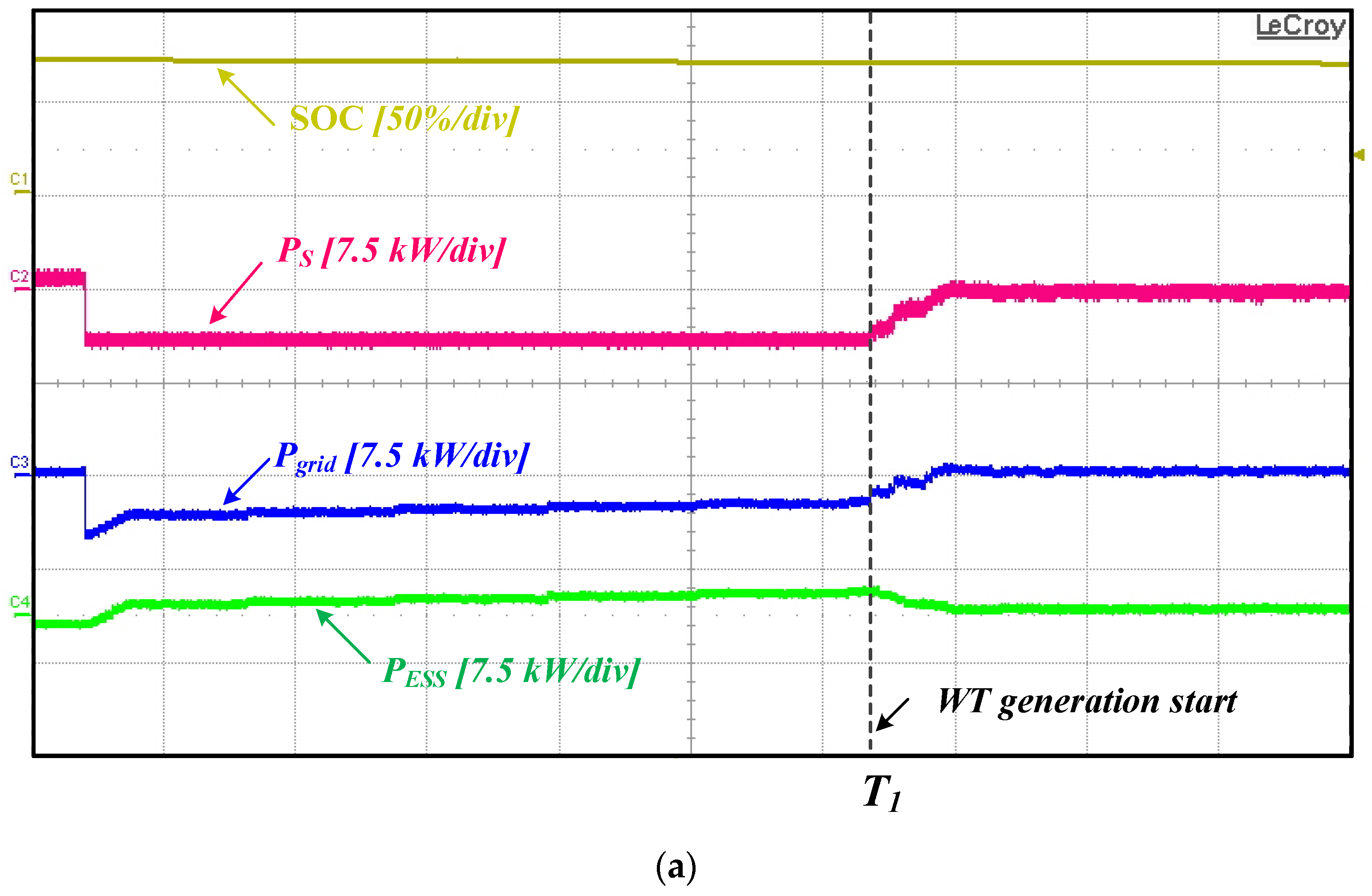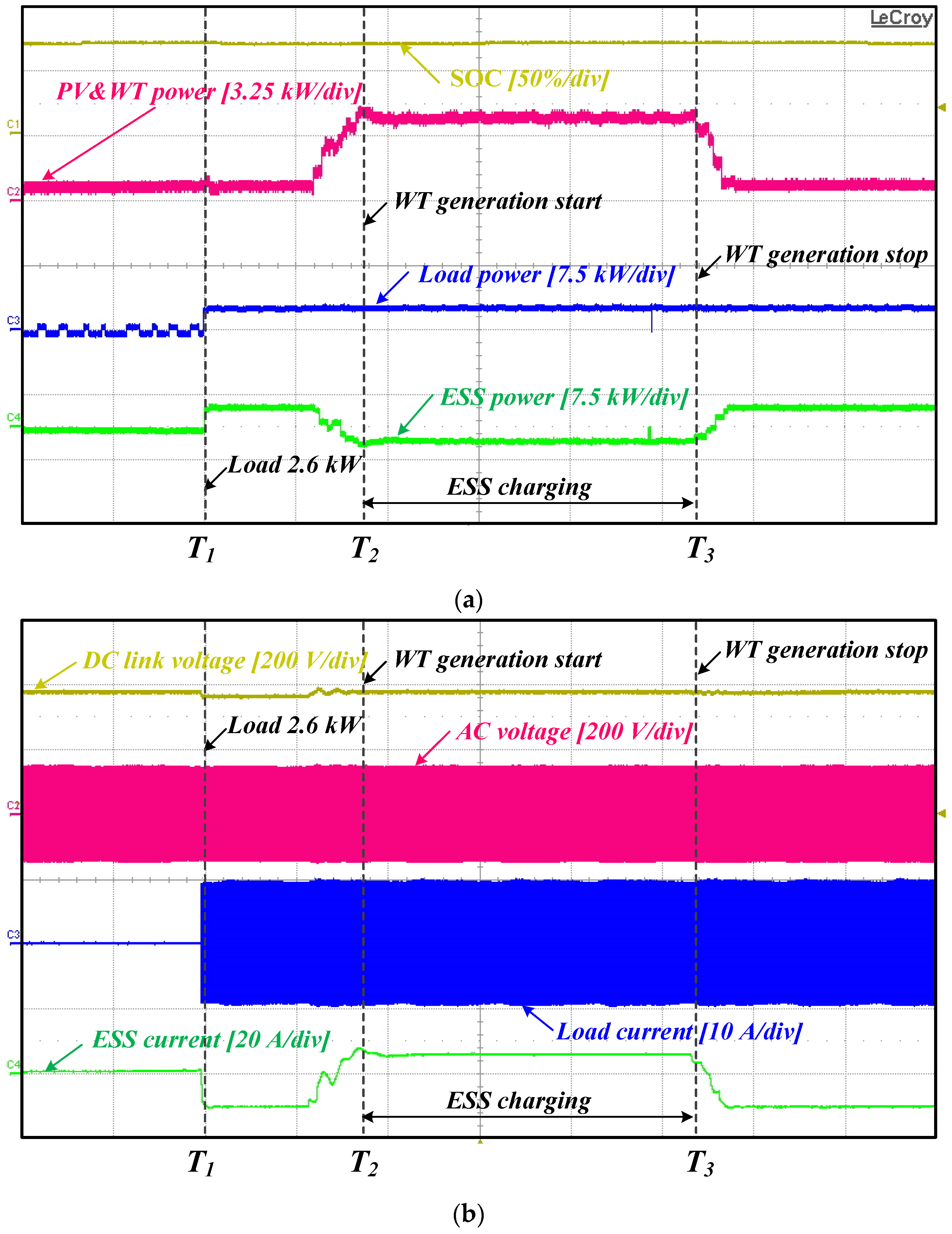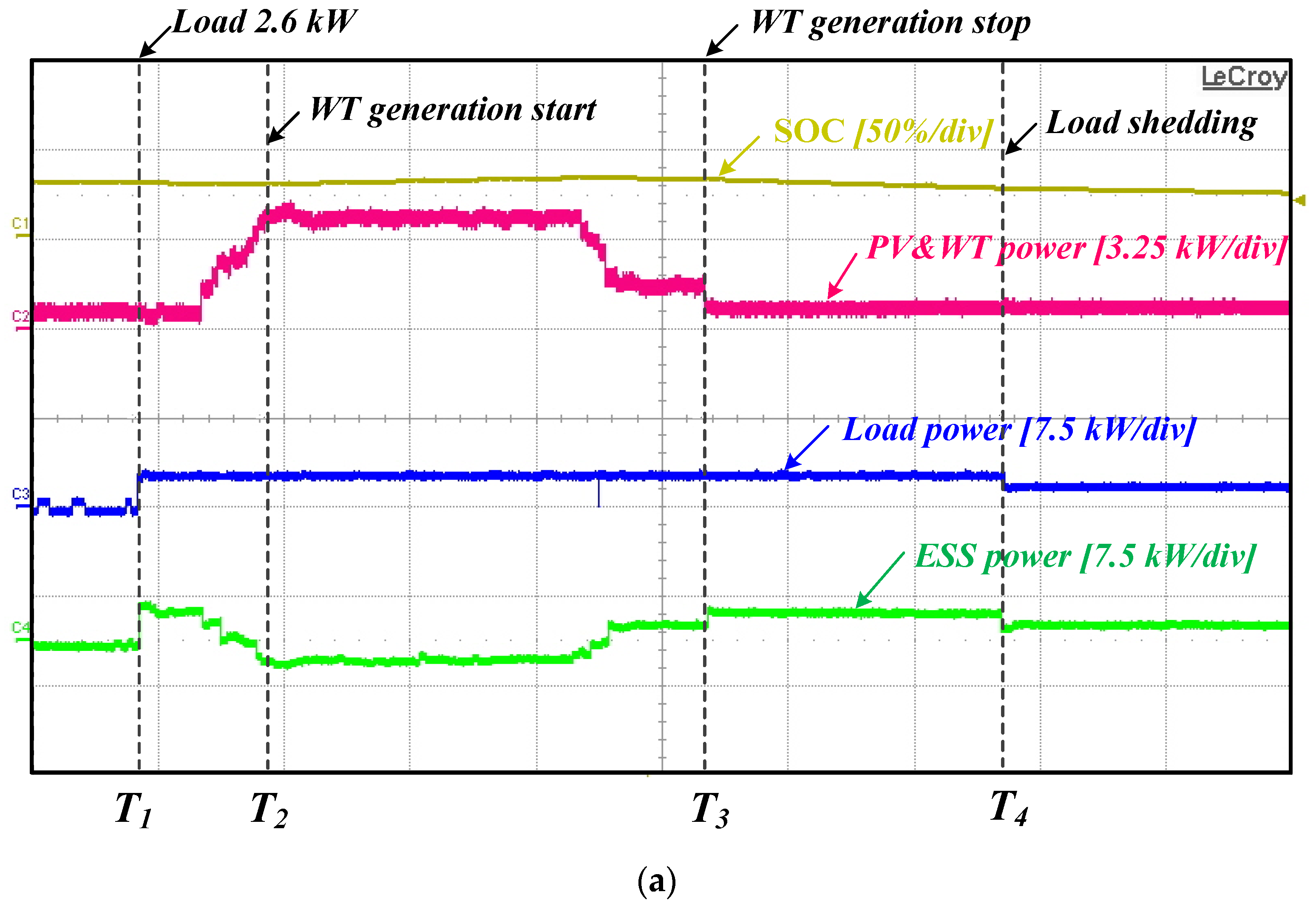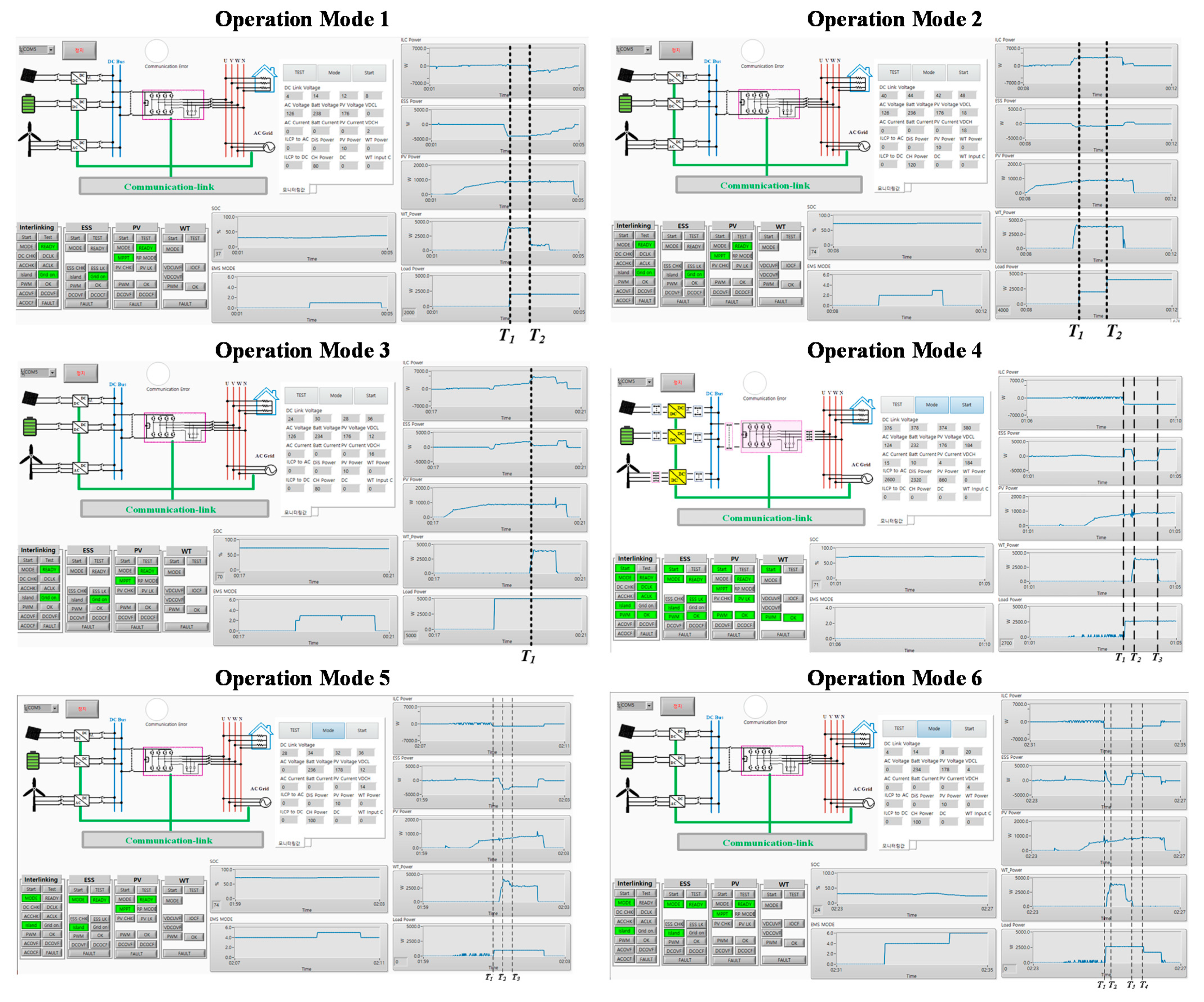Figure 1.
Classification of microgrids according to distribution network configuration (a) DC microgrid, (b) AC microgrid, (c) hybrid AC/DC microgrid.
Figure 1.
Classification of microgrids according to distribution network configuration (a) DC microgrid, (b) AC microgrid, (c) hybrid AC/DC microgrid.
Figure 2.
Two types of control structure for EMSs (a) decentralized control, (b) centralized control.
Figure 2.
Two types of control structure for EMSs (a) decentralized control, (b) centralized control.
Figure 3.
Configuration diagram of hybrid AC/DC distribution network.
Figure 3.
Configuration diagram of hybrid AC/DC distribution network.
Figure 4.
Hierarchical control structure of the proposed EMS and control block diagram of each power converter.
Figure 4.
Hierarchical control structure of the proposed EMS and control block diagram of each power converter.
Figure 5.
Flowchart of the proposed EMS.
Figure 5.
Flowchart of the proposed EMS.
Figure 6.
Configuration of the proposed ANN.
Figure 6.
Configuration of the proposed ANN.
Figure 7.
Power flow diagram of ESS charge mode (mode 1).
Figure 7.
Power flow diagram of ESS charge mode (mode 1).
Figure 8.
Power flow diagram of the power regeneration mode (mode 2).
Figure 8.
Power flow diagram of the power regeneration mode (mode 2).
Figure 9.
Power flow diagram of the ESS discharge mode (mode 3).
Figure 9.
Power flow diagram of the ESS discharge mode (mode 3).
Figure 10.
Power flow diagram of the stand-alone mode (mode 4).
Figure 10.
Power flow diagram of the stand-alone mode (mode 4).
Figure 11.
Power flow diagram of the RP mode (mode 5).
Figure 11.
Power flow diagram of the RP mode (mode 5).
Figure 12.
Power flow diagram of the load shedding mode (mode 6).
Figure 12.
Power flow diagram of the load shedding mode (mode 6).
Figure 13.
Simulation results of ANN training (a) ESS charge mode, (b) power regeneration mode, (c) ESS discharge mode.
Figure 13.
Simulation results of ANN training (a) ESS charge mode, (b) power regeneration mode, (c) ESS discharge mode.
Figure 14.
Load pattern and distributed power generation amount in reference to time applied to simulation.
Figure 14.
Load pattern and distributed power generation amount in reference to time applied to simulation.
Figure 15.
Simulation result of EMS when applying ANN theory.
Figure 15.
Simulation result of EMS when applying ANN theory.
Figure 16.
Experiment configuration of the hybrid AC/DC microgrid.
Figure 16.
Experiment configuration of the hybrid AC/DC microgrid.
Figure 17.
Configuration of the 10 kW class ILC hardware set.
Figure 17.
Configuration of the 10 kW class ILC hardware set.
Figure 18.
Configuration of the hardware set for ESS and PV (a) converter for ESS, (b) converter for PV.
Figure 18.
Configuration of the hardware set for ESS and PV (a) converter for ESS, (b) converter for PV.
Figure 19.
Configuration of the wind generation system hardware set (a) 3-level NPC, (b) MG-set.
Figure 19.
Configuration of the wind generation system hardware set (a) 3-level NPC, (b) MG-set.
Figure 20.
Experiment waveforms of operation mode 1 (a) ANN input/output data waveform, (b) Voltage and current waveforms in major parts.
Figure 20.
Experiment waveforms of operation mode 1 (a) ANN input/output data waveform, (b) Voltage and current waveforms in major parts.
Figure 21.
Experiment waveforms of operation mode 2 (a) ANN input/output data waveform, (b) Voltage and current waveforms in major parts.
Figure 21.
Experiment waveforms of operation mode 2 (a) ANN input/output data waveform, (b) Voltage and current waveforms in major parts.
Figure 22.
Experiment waveforms of operation mode 3 (a) ANN input/output data waveform, (b) Voltage and current waveforms in major parts.
Figure 22.
Experiment waveforms of operation mode 3 (a) ANN input/output data waveform, (b) Voltage and current waveforms in major parts.
Figure 23.
Experiment waveforms of operation mode 4 (a) Power quantity of major parts and SOC, (b) Voltage and current waveforms in major parts.
Figure 23.
Experiment waveforms of operation mode 4 (a) Power quantity of major parts and SOC, (b) Voltage and current waveforms in major parts.
Figure 24.
Experiment waveforms of operation mode 5 (a) Power quantity of major parts and SOC, (b) Voltage and current waveforms in major parts.
Figure 24.
Experiment waveforms of operation mode 5 (a) Power quantity of major parts and SOC, (b) Voltage and current waveforms in major parts.
Figure 25.
Experiment waveforms of operation mode 6 (a) Power quantity of major parts and SOC, (b) Voltage and current waveforms in major parts.
Figure 25.
Experiment waveforms of operation mode 6 (a) Power quantity of major parts and SOC, (b) Voltage and current waveforms in major parts.
Figure 26.
Screen configuration of EMS monitoring system according to each operation mode.
Figure 26.
Screen configuration of EMS monitoring system according to each operation mode.
Table 1.
ANN training data of mode 1.
Table 1.
ANN training data of mode 1.
| Sample | Input Data | Output Data |
|---|
| SOC (P.U) | Ps (P.U) | WGrid (P.U) | PESS (P.U) |
|---|
| 1 | 0.1 | −0.5 | 0.3 | 0.5 |
| 2 | 0.5 | 0.4 |
| 3 | 0.7 | 0.3 |
| 4 | 0 | 0.3 | 0.75 |
| 5 | 0.5 | 0.65 |
| 6 | 0.7 | 0.55 |
| 7 | 0.5 | 0.3 | 1 |
| 8 | 0.5 | 0.9 |
| 9 | 0.7 | 0.8 |
| 10 | 0.3 | −0.5 | 0.3 | 0.348 |
| 11 | 0.5 | 0.23 |
| 12 | 0.7 | 0.112 |
| 13 | 0 | 0.3 | 0.673 |
| 14 | 0.5 | 0.555 |
| 15 | 0.7 | 0.437 |
| 16 | 0.5 | 0.3 | 0.998 |
| 17 | 0.5 | 0.88 |
| 18 | 0.7 | 0.762 |
Table 2.
ANN training data of mode 2.
Table 2.
ANN training data of mode 2.
| Sample | Input Data | Output Data |
|---|
| SOC (P.U) | Ps (P.U) | WGrid (P.U) | PESS (P.U) |
|---|
| 1 | 0.5 | 0.3 | 0.3 | 0.27 |
| 2 | 0.5 | 0.17 |
| 3 | 0.7 | 0.07 |
| 4 | 0.7 | 0.3 | 0.63 |
| 5 | 0.5 | 0.53 |
| 6 | 0.7 | 0.43 |
| 7 | 0.7 | 0.3 | 0.3 | 0.21 |
| 8 | 0.5 | 0.11 |
| 9 | 0.7 | 0.01 |
| 10 | 0.7 | 0.3 | 0.57 |
| 11 | 0.5 | 0.47 |
| 12 | 0.7 | 0.37 |
| 13 | 0.9 | 0.3 | 0.3 | 0.166 |
| 14 | 0.5 | 0.076 |
| 15 | 0.7 | 0 |
| 16 | 0.7 | 0.3 | 0.526 |
| 17 | 0.5 | 0.436 |
| 18 | 0.7 | 0.346 |
Table 3.
ANN training data of mode 3.
Table 3.
ANN training data of mode 3.
| Sample | Input Data | Output Data |
|---|
| SOC (P.U) | Ps (P.U) | WGrid (P.U) | PESS (P.U) |
|---|
| 1 | 0.5 | −0.7 | 0.3 | 0.177 |
| 2 | 0.5 | 0.295 |
| 3 | 0.7 | 0.413 |
| 4 | −0.3 | 0.3 | 0.327 |
| 5 | 0.5 | 0.445 |
| 6 | 0.7 | 0.563 |
| 7 | 0.7 | −0.7 | 0.3 | 0.277 |
| 8 | 0.5 | 0.395 |
| 9 | 0.7 | 0.513 |
| 10 | −0.3 | 0.3 | 0.173 |
| 11 | 0.5 | 0.645 |
| 12 | 0.7 | 0.763 |
| 13 | 0.9 | −0.7 | 0.3 | 0.269 |
| 14 | 0.5 | 0.387 |
| 15 | 0.7 | 0.505 |
| 16 | −0.3 | 0.3 | 0.519 |
| 17 | 0.5 | 0.637 |
| 18 | 0.7 | 0.755 |
Table 4.
Power flow of each power converter in operation mode 1.
Table 4.
Power flow of each power converter in operation mode 1.
| Parameter | Value | Unit |
|---|
| T1~T2 | After T2 |
|---|
| Interlinking Converter | 0.5 | −1.1 | kW |
| ESS Converter | 4.3 | 2.1 | kW |
| PV Converter | 1 | 1 | kW |
| WT Converter | 3.8 | 0 | kW |
| Load Demand | 2 | 2 | kW |
Table 5.
Power flow of each power converter in operation mode 2.
Table 5.
Power flow of each power converter in operation mode 2.
| Parameter | Value | Unit |
|---|
| T1~T2 | After T2 |
|---|
| Interlinking Converter | 3.8 | 4.3 | kW |
| ESS Converter | 1 | 0.5 | kW |
| PV Converter | 1 | 1 | kW |
| WT Converter | 3.8 | 3.8 | kW |
| Load Demand | 2 | 4 | kW |
Table 6.
Power flow of each power converter in operation mode 3.
Table 6.
Power flow of each power converter in operation mode 3.
| Parameter | Value | Unit |
|---|
| Before T1 | After T1 |
|---|
| Interlinking Converter | 2.5 | 5.3 | kW |
| ESS Converter | −1.5 | −0.5 | kW |
| PV Converter | 1 | 1 | kW |
| WT Converter | 0 | 3.8 | kW |
| Load Demand | 5 | 5 | kW |
Table 7.
Power flow of each power converter in operation mode 4.
Table 7.
Power flow of each power converter in operation mode 4.
| Parameter | Value | Unit |
|---|
| T1~T2 | T2~T3 | After T3 |
|---|
| Interlinking Converter | 2.6 | kW |
| ESS Converter | −1.6 | 2.2 | −1.6 | kW |
| PV Converter | 1 | kW |
| WT Converter | 0 | 3.8 | 0 | kW |
| Load Demand | 2.6 | kW |
Table 8.
Power flow of each power converter in operation mode 5.
Table 8.
Power flow of each power converter in operation mode 5.
| Parameter | Value | Unit |
|---|
| T1~T3 | After T3 |
|---|
| Interlinking Converter | 1 | kW |
| ESS Converter | −3.6 | −2.3 | kW |
| PV Converter | 0.8 | | kW |
| WT Converter | 3.8 | 2.5 | kW |
| Load Demand | 1 | kW |
| Grid Regenerative Power | 0 | kW |
Table 9.
Power flow of each power converter in operation mode 6.
Table 9.
Power flow of each power converter in operation mode 6.
| Parameter | Value | Unit |
|---|
| Before T3 | T3~T4 | After T4 |
|---|
| Interlinking Converter | 2.6 | 1.8 | kW |
| ESS Converter | −1.4 | 0.8 | kW |
| PV Converter | 32 | | kW |
| WT Converter | 1 | kW |
| Load Demand | 3 | 0 | kW |
| Grid Regenerative Power | 2.6 | 1.8 | kW |
